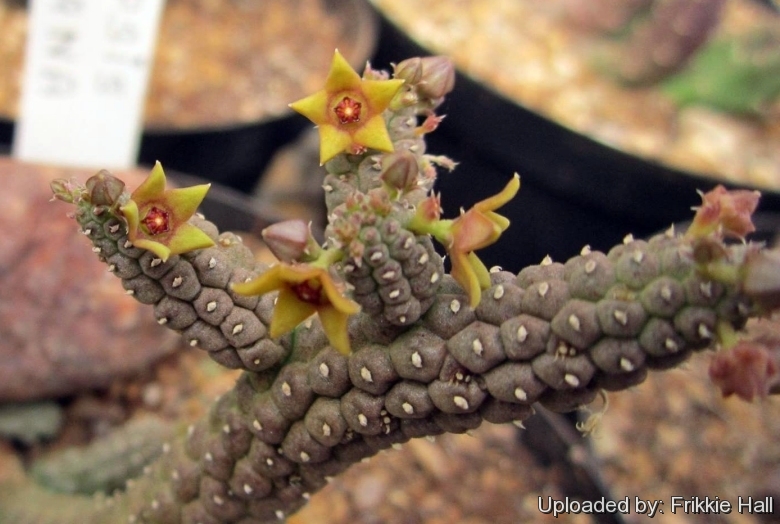




Your support is critical to our success.

Origin and Habitat: Echidnopsis socotranaSN|32957]]SN|32957]] is a rare species, with a very limited area of occupancy. Endemic to Soqotra, Yemen.
Altitude range: 500–700 metres above sea level.
Habitat and Ecology: This species is widespread on the limestone plateau; in thin soil beneath bushes and in the shade of rocks in dwarf succulent shrubland, mainly on the southwest rocky slopes. Here it grows abundantly together with Edithcolea grandisSN|26305]]SN|26305]]. Possibly the commonest and most widespread species of Echidnopsis on the island.
Synonyms:
- Echidnopsis socotrana Lavranos
Description: Echidnopsis socotranaSN|33117]]SN|32957]] is a tiny perennial succulent with reclining, creeping, few-branched stems. It is distinguished by the yellow flowers with red centre.
Stems: Decumbent, cylindrical, vividly green or flushed entirely coppery-red or brown in dry conditions, 3-7 cm long, 6-10 mm thick. Tubercles, hexagonal, arranged in 6 longitudinal ribs, apically with leaf-rudiment, this ovate-deltoid, short, dark green, soon withering and caducous.
Inflorescence: Sprouting out mainly toward the tip of stems, with 1-2 flowers opening in succession, closely appressed to the stem or with a short pedicel up to 1 mm long.
Flowers: Sepals deltoid, 1.5 mm. Corolla yellow, 5 mm in diameter, campanulate, tube rather flat. Corolla-lobes erect, deltoid, 3 mm long, basally approx. 3 mm broad, margins revolute, glabrous on both sides. Corona pentagonal, 3 mm in diameter. Outer corona lobes dark reddish-brown, glossy, deeply 5-partite, cup-shaped, lobes ascending, deltoid, apically blunt, in the middle with longitudinal furrow, margins laterally bulging, glabrous. Inner corona-lobes yellow, lower part covered by the outer corona lobes, lobes ribbon-shaped, apically rounded, lying more or less vertically on the anthers, not meeting above the style head.
Taxonomy notes: Probably Echidnopsis socotranaSN|32957]]SN|32957]] is better placed under Echidnopsis scutellataSN|32957]]SN|33117]] as a further subspecies.
Bibliography: Major references and further lectures
1) Focke Albers, Ulrich Meve “Illustrated Handbook of Succulent Plants: Asclepiadaceae: Asclepiadaceae” Volume 4 Springer Science & Business Media, 2002
2) Miller, A. 2004. Echidnopsis socotrana. The IUCN Red List of Threatened Species 2004: e.T44765A10936160. http://dx.doi.org/10.2305/IUCN.UK.2004.RLTS.T44765A10936160.en. Downloaded on 15 May 2016.
3) J.J. Lavranos, 1993 In: Cact. Succ. J. (U.S.A.), 65(6): 294
Cultivation and Propagation: Echidnopsis socotranaSN|32957]]SN|32957]] has very specific growing needs with much light and relatively high (above 15°C) winter temperatures. It’s susceptible to rot in combination with low temperatures, but given the right growing conditions it is an easy blooming plant.
Potting medium: Since roots are quite shallow, use a cactus mix or add extra perlite or pumice to regular soil potting soil. A gritty, very free-draining compost is suitable, and clay pots help the plants to dry out between watering.
Watering: It require moderately watering through the growing season but enjoy plenty of water and some fertiliser in hot weather and allow them to dry before watering again , this helps them to flower freely. Water sparingly in winter according to temperatures. But, as with most asclepiads, it is unwise to leave them wet in cold weather. Winter care presents no problems at 15°C with plenty of light.
Sun Exposure: Partial sun or light shade
Pest and diseases: They are very susceptible to stem and root mealy bugs, and damage from these may well initiate fungal attack. If you do have problems with a stem or with basal rotting, you can reliably isolate the healthy parts, dry them off, and re-root them in moist compost.
Cultural Practices: Re-pot every 2 years.
Propagation: Easiest with stem cuttings. Allow cuttings to dry a day before planting. Stems must be laid (Not buried) on gritty compost and will then root from the underside of the stems. It can also be increased from seeds sowing in spring in moist, sandy peat moss.
| Your Actions | |
|---|---|
| Back to Echidnopsis index | |
| Back to Asclepiadaceae index | |
 |
Back to Succulents Encyclopedia index |
Privacy stantement - Terms and conditions - How to cite - About us - Feedback - Donate




